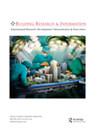Implementing modular integrated construction in high-rise high-density cities: perspectives in Hong Kong
IF 3.7
3区 工程技术
Q1 CONSTRUCTION & BUILDING TECHNOLOGY
引用次数: 4
Abstract
ABSTRACT Modular construction has been widely promoted with numerous benefits, but the promotion has largely been for low- to medium-rise buildings. The implementation of high-rise modular buildings in high-density cities remains limited. This paper aims to investigate modular adoption in high-rise high-density cities by examining drivers, constraints and strategies with the case of modular integrated construction in Hong Kong. The research was carried out through a literature review, expert interviews and a questionnaire survey with key stakeholders. The most important drivers were identified to be faster construction and shortened project duration, financial incentives, better quality control, policy initiative and promotion and improved workers’ well-being. The most significant constraints were found to be over-stringent regulations, limited codes and standards, limited capable suppliers and contractors, logistics challenges and loss of saleable areas. The most important success strategies were identified relating to financial incentives, standards and codes, technical solutions, transport regulations and prioritized adoption in public housing. A systems framework is proposed to address the complexity of modular adoption within social, technological, economic, supply chain and regulatory contexts. The findings should help accelerate the adoption of modular methods in high-rise high-density cities and contribute a systematic approach to informing future research into modular construction.在高层高密度城市实施模块化综合建设:香港视角
模块化建筑已经得到了广泛的推广,带来了许多好处,但推广主要针对中低层建筑。高层模块化建筑在高密度城市的实施仍然有限。本文旨在以香港的模块化综合建设为例,通过考察驱动因素、制约因素和策略,研究高层高密度城市的模块化采用。该研究通过文献综述、专家访谈和对主要利益相关者的问卷调查进行。最重要的驱动因素是更快的施工和缩短项目工期、财政激励、更好的质量控制、政策主动性和促进以及改善工人的福祉。最重要的制约因素是过于严格的法规、有限的规范和标准、能力有限的供应商和承包商、物流挑战和可销售面积的损失。确定了最重要的成功战略,涉及财政激励、标准和规范、技术解决方案、交通法规和公共住房优先采用。提出了一个系统框架,以解决社会、技术、经济、供应链和监管环境中模块化采用的复杂性。这些发现应有助于加快高层高密度城市采用模块化方法,并为未来模块化建筑的研究提供系统的方法。
本文章由计算机程序翻译,如有差异,请以英文原文为准。
求助全文
约1分钟内获得全文
求助全文
来源期刊

Building Research and Information
工程技术-结构与建筑技术
CiteScore
8.60
自引率
7.70%
发文量
43
审稿时长
>12 weeks
期刊介绍:
BUILDING RESEARCH & INFORMATION (BRI) is a leading international refereed journal focussed on buildings and their supporting systems. Unique to BRI is a focus on a holistic, transdisciplinary approach to buildings and the complexity of issues involving the built environment with other systems over the course of their life: planning, briefing, design, construction, occupation and use, property exchange and evaluation, maintenance, alteration and end of life. Published articles provide conceptual and evidence-based approaches which reflect the complexity and linkages between cultural, environmental, economic, social, organisational, quality of life, health, well-being, design and engineering of the built environment.
 求助内容:
求助内容: 应助结果提醒方式:
应助结果提醒方式:


